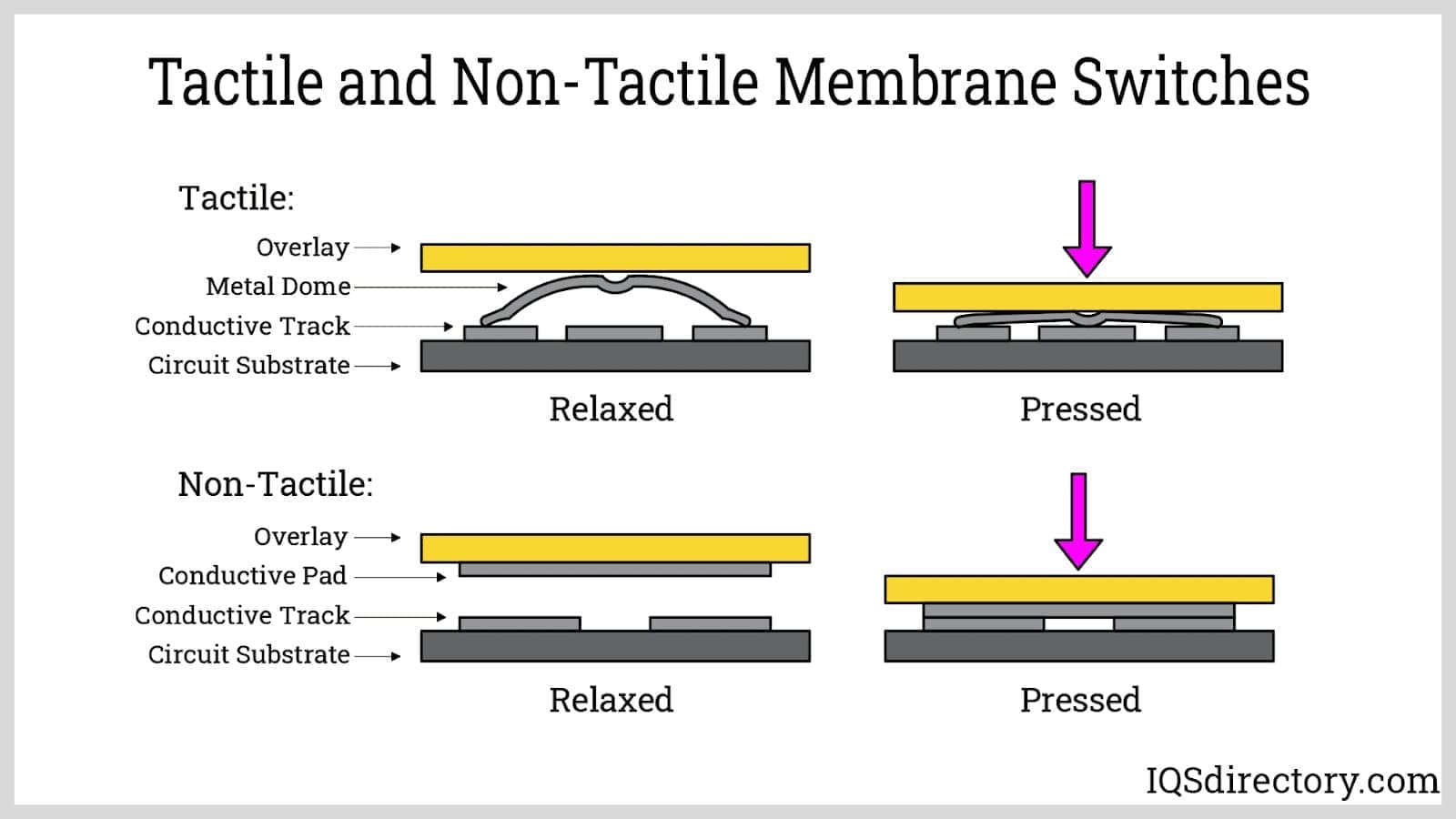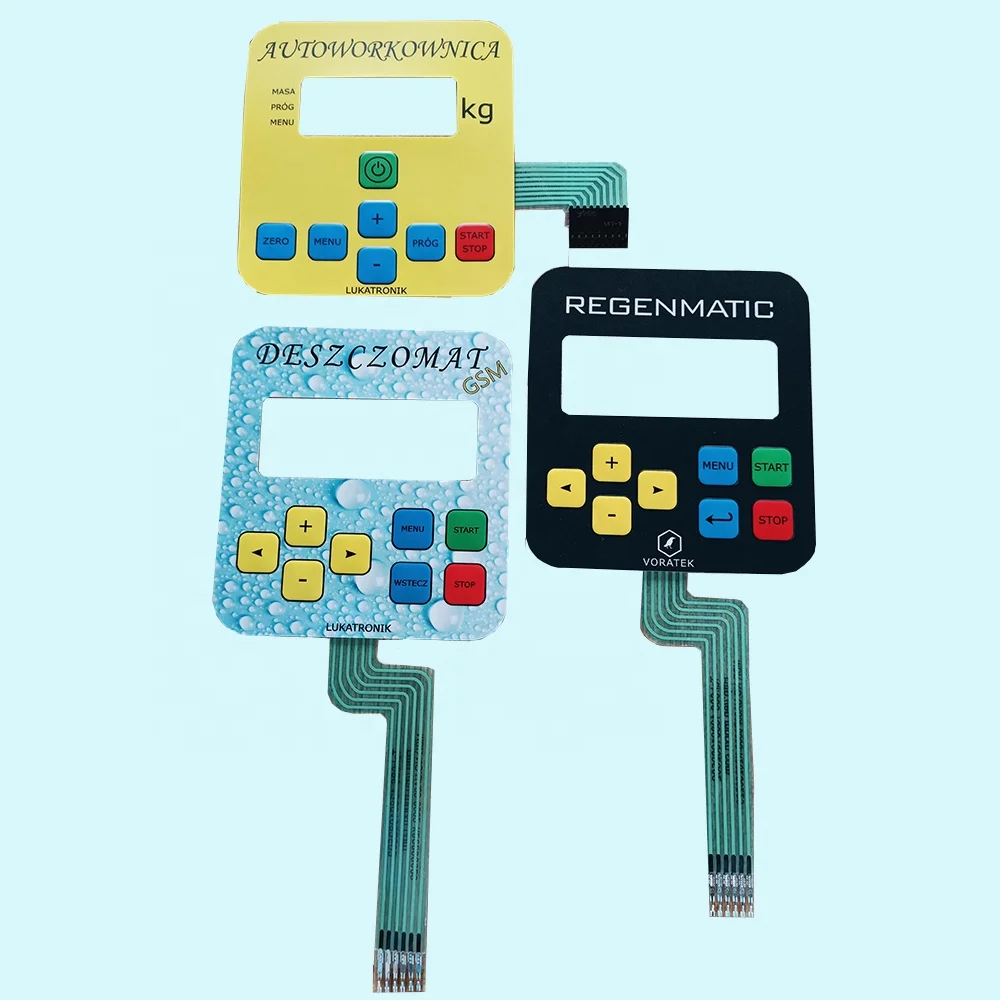Membrane Switch Manufacturer with Quick Prototyping and Turnaround
Membrane Switch Manufacturer with Quick Prototyping and Turnaround
Blog Article
Recognizing the Significance of Membrane Switch in Modern Electronic Devices and Their Applications
Membrane changes work as a vital component in contemporary electronic devices, providing a reliable interface for individual interaction. Their adjustable and light-weight nature makes them suitable for a variety of applications throughout varied industries. Understanding their vital elements and advantages can supply insights right into their expanding importance. As technology remains to advancement, the advancement of Membrane changes questions concerning their future applications and design advancements. What lies in advance in this dynamic area?

What Are Membrane Buttons?
Membrane switches are essential elements in modern electronic devices, functioning as interface that promote communication between devices and users. These buttons are composed of numerous layers, including a visuals overlay, an adhesive layer, and a circuit layer, every one of which collaborate to develop a functional and resilient interface. The style permits a level, inconspicuous option that can be customized regarding dimension, shape, and aesthetic appearance, making them appropriate for numerous applications, from customer electronic devices to clinical devices. The tactile responses provided by Membrane switches improves individual experience, while their resistance to dirt and moisture makes them excellent for testing environments. Membrane switches can include attributes such as backlighting and published graphics, even more broadening their use. Their convenience and effectiveness make them a favored choice in sectors where integrity and ease of use are paramount, inevitably adding to the seamless procedure of contemporary electronic tools.
Trick Components of Membrane Switches Over
While various components add to the functionality of a membrane button, three main layers play significant duties in its layout and operation. The top layer, typically made from a long lasting polymer, offers as the interface for user communication, usually featuring published graphics and icons. Below this is the spacer layer, which preserves the necessary range in between the top layer and the circuit layer. This spacer layer warranties that the button triggers just when pushed, protecting against unintentional inputs. The circuit layer consists of conductive traces that finish the electric circuit when the top layer is depressed. These traces can be made from different materials, including copper or silver. Together, these parts produce a reputable and robust device that is compact and flexible, appropriate for a vast array of digital applications, from home devices to medical devices. Recognizing these key parts is essential for valuing the general performance of Membrane buttons.
Advantages of Making Use Of Membrane Changes

Membrane Switch Production Refine
Comprehending the Membrane button manufacturing process reveals the intricate steps entailed in generating these necessary parts. The process normally starts with the style stage, where specs and formats are created using specialized software program. Following this, the graphic overlay is published on an adaptable substratum, usually using high-resolution printing methods to guarantee quality and precision.Next, the adhesive layers are applied, which offer to bond the numerous elements together. The circuit layers, made from conductive inks or products, are after that published onto a different substrate. These layers are meticulously straightened and laminated to produce a useful switch.After setting up, the switches go through testing to validate functionality and resilience. Quality assurance actions are applied throughout the procedure to recognize and fix any kind of defects. Lastly, the finished Membrane switches are packaged and planned for circulation, prepared to meet the demands of modern electronic applications.
Applications of Membrane Switches Over in Different Industries
Membrane switches are progressively utilized throughout various markets, specifically in clinical tools and consumer electronic devices. In the medical area, they provide dependable control interfaces for devices that call for precise operation. Likewise, in consumer electronic devices, these switches improve user communication by using responsive and sleek interfaces.
Medical Devices Control
Numerous modern-day clinical tools utilize Membrane buttons for streamlined operation and boosted customer interaction. These buttons offer a dependable, resilient interface for a variety of applications, consisting of diagnostic devices, person surveillance systems, and medical instruments. Their personalized layouts permit details designs that can accommodate the distinct demands of healthcare experts, making sure instinctive navigation and efficient access to important functions. Additionally, Membrane switches are immune to contaminants, making them ideal for clean and sterile atmospheres. The responsive feedback they provide can boost customer confidence, reducing the danger of mistakes throughout crucial clinical treatments. Overall, the integration of Membrane buttons in clinical tools significantly contributes to boosted operational performance and patient safety and security in healthcare setups.
Consumer Electronics Interfaces
In the domain name of customer electronics, Membrane switches play a critical duty in enhancing individual interfaces throughout a variety of devices. These buttons are indispensable to products such as push-button controls, microwaves, and pc gaming consoles, offering a easy to use and efficient user interface. Their design enables for a seamless assimilation of graphics and capability, allowing makers to develop sleek, modern looks without jeopardizing functionality. Membrane buttons are likewise known for their longevity, typically holding up against extensive use and exposure to different environmental problems. Furthermore, they can include features like backlighting and tactile feedback, further improving the user experience. As consumer demands for sophisticated yet intuitive user interfaces expand, Membrane changes remain to be a crucial part in progressing digital gadget performance.
Design Considerations for Membrane Changes
Designing effective Membrane switches over calls for cautious attention to various variables that affect both performance and user experience. One essential factor to consider is the option of materials, as they can influence longevity, responsive feedback, and visual charm. Selecting an ideal adhesive is necessary for ensuring long-term adhesion and resistance to ecological factors.In enhancement, the layout and layout of the button must fit customer interaction, with switch dimensions and spacing enhanced for simplicity of usage. The consolidation of graphics and labeling ought to focus on clarity and visibility under numerous illumination conditions.Consideration of electrical features, such as actuation force and switch sensitivity, will certainly enhance the responsiveness of the Membrane button. Furthermore, the design must suit manufacturing procedures to ensure cost-effectiveness and prompt production. best site In general, a well-balanced design boosts both the customer and the capability experience of Membrane switches in modern-day electronics.

Future Patterns in Membrane Switch Modern Technology
As technology continues to develop, Membrane switches are poised to incorporate brand-new advancements that will enhance their performance and application in different fields. One considerable fad is the incorporation of long lasting and versatile products, which will certainly increase the lifespan and dependability of these switches. Improved surface textures and adjustable graphics are likewise expected, enabling for more user-friendly user interfaces.Moreover, the integration of smart technology, such as touch-sensitive surfaces and haptic feedback, is over here anticipated to boost customer communication, making Membrane switches much more interesting and receptive. Furthermore, breakthroughs in published electronics will make it possible for extra intricate wiring within thinner profiles, further expanding layout possibilities.Sustainability will certainly also play a vital duty in future growths, as manufacturers check out eco-friendly products and production procedures. Generally, these patterns will assure that Membrane switches over stay appropriate and essential in an interconnected and significantly digital globe.
Often Asked Questions
Just How Do Membrane Switches Over Compare to Traditional Mechanical Buttons?
Membrane changes deal advantages over conventional mechanical buttons, including reduced dimension, lighter weight, and improved toughness. They usually provide a secured surface area, improving resistance to dirt and wetness, making them optimal for varied applications.
What Materials Are Generally Used in Membrane Switch Construction?

Can Membrane Switches Withstand Extreme Environmental Issues?
Membrane buttons can stand up to extreme ecological problems, depending upon their layout and materials. High-grade buildings usually feature toughness against temperature fluctuations, humidity, and direct exposure to chemicals, making them suitable for different requiring applications throughout industries.
For How Long Do Membrane Changes Commonly Last Before Failure?
Membrane changes typically display a life expectancy varying from 1 to 10 million actuations, depending on aspects such as use regularity, environmental conditions, and producing high quality. Normal upkeep can extend their sturdiness and functional integrity considerably.
Are Membrane Switches Adjustable for Certain Applications?
Membrane buttons are without a doubt personalized for specific applications. They can be tailored in style, performance, and size, enabling makers to satisfy special individual demands and improve product aesthetic appeals while preserving operational efficiency and resilience. Membrane buttons are crucial parts in modern-day electronic devices, serving as user interfaces that facilitate interaction in between customers and devices. The responsive comments supplied by Membrane switches boosts individual experience, while their resistance to dust and moisture makes them ideal for testing atmospheres. The incorporation of graphics and labeling should focus on quality and exposure under various lights conditions.Consideration of electric characteristics, such as actuation pressure and button sensitivity, will certainly improve the responsiveness of the Membrane switch. Boosted surface area textures and personalized graphics are likewise anticipated, permitting for more instinctive individual interfaces.Moreover, the integration of discover here wise technology, such as touch-sensitive surface areas and haptic responses, is anticipated to enhance user communication, making Membrane changes more interesting and responsive. Membrane switches offer advantages over traditional mechanical switches, consisting of minimized size, lighter weight, and enhanced resilience.
Report this page